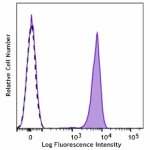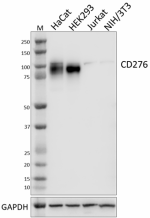- Clone
- A20079E (See other available formats)
- Regulatory Status
- RUO
- Other Names
- Cluster of differentiation 276 (CD276), B7 Homolog 3 (B7-H3), 4Ig-B7-H3, B7RP-2
- Isotype
- Mouse IgG1, κ
- Ave. Rating
- Submit a Review
- Product Citations
- publications

-

IHC staining of purified anti-CD276 (B7-H3) (clone A20079E) on formalin-fixed paraffin-embedded human tonsil tissue. Following antigen retrieval using Sodium Citrate H.I.E.R., 1x (Cat. No. 928502), the tissue was incubated without (panel A) and with (panel B) 5 µg/mL of primary antibody followed by incubation with Alexa Fluor® 647 goat anti-mouse IgG (Cat. No. 405322) for 1 hour at room temperature. Nuclei were counterstained with DAPI (Cat. No. 422801). Images were captured in an Olympus IX83 Inverted Microscope with a 20X objective. Scale bar: 50 µm -

HaCat cells (positive control, filled histogram) and Jurkat cells (low expression control, open histogram) were stained with purified anti-CD276 (B7-H3) (clone A20079E ), or mouse IgG1, κ isotype control (open histogram, dashed line) (representative histogram for both cell lines) (Cat No. 401402) followed by PE goat anti-mouse IgG (Cat. No. 405307). -

ICC staining of purified anti-CD276 (B7-H3) (clone A20079E ) on HaCaT cells. The cells were fixed and permeabilized with ice-cold MeOH, then blocked with 5% FBS for 1 hour at room temperature. The cells were then stained with either 5 µg/mL of purified mouse IgG1, κ isotype control (Cat. No. 401402) (panel A) or 1.25 µg/mL of the primary antibody (panel B) overnight at 4°C, followed by incubation with 2.5 µg/mL of Alexa Fluor® 594 goat anti-mouse IgG (Cat. No. 405326) for 1 hour at room temperature. Nuclei were counterstained with DAPI (Cat. No. 422801), and the images were captured with a 60X objective. Scale: 50 µm -

Whole cell extracts (15 µg total protein) from the indicated cell lines were resolved on a 4-12% Bis-Tris gel, transferred to a PVDF membrane, and probed with 1 µg/mL of purified anti-CD276 (B7-H3) (clone A20079E ) overnight at 4°C. Proteins were visualized by chemiluminescence detection using HRP goat anti-mouse IgG (Cat. No. 405306) at a 1:3000 dilution. Direct-Blot™ HRP anti-GAPDH (Cat. No. 607904) was used as a loading control at a 1:50000 dilution. Western-Ready™ ECL Substrate Premium Kit (Cat. No. 426319) was used as a detection agent. Lane M: Molecular weight marker
| Cat # | Size | Price | Quantity Check Availability | Save | ||
|---|---|---|---|---|---|---|
| 616951 | 25 µg | 144€ | ||||
| 616952 | 100 µg | 360€ | ||||
CD276, or B7-H3, is a type I transmembrane protein and shares 20-27% amino acid identity with other B7 family members. Human CD276 has a single extracellular variable-type immunoglobulin (IgV)-IgC domain and a signature intracellular domain. There also exists an additional isoform known as 4Ig-B7-H3, containing a nearly exact tandem duplication of the IgV-IgC domain. Expression of CD276 is induced on T cells, natural killer (NK) cells, and antigen-presenting cells (APCs), including dendritic cells (DCs) and macrophages, and is upregulated during the maturation of monocytes to DCs, or following interactions between DCs and regulatory T cells. CD276 inhibits T-cell responses, and plays a role in adaptive immunity by suppressing T cell activation. CD276 is also expressed in various cancers, where it works to suppress tumor antigen-specific immune responses.
Product DetailsProduct Details
- Verified Reactivity
- Human
- Antibody Type
- Monoclonal
- Host Species
- Mouse
- Immunogen
- Recombinant fragment of human CD276
- Formulation
- Phosphate-buffered solution, pH 7.2, containing 0.09% sodium azide
- Preparation
- The antibody was purified by affinity chromatography.
- Concentration
- 0.5 mg/mL
- Storage & Handling
- The antibody solution should be stored undiluted between 2°C and 8°C.
- Application
-
IHC-P - Quality tested
FC, ICC, WB - Verified - Recommended Usage
-
Each lot of this antibody is quality control tested by formalin-fixed paraffin-embedded immunohistochemical staining. For immunohistochemistry, a concentration range of 1.0 - 10.0 µg/mL is suggested. For flow cytometric staining, the suggested use of this reagent is ≤ 0.03 µg per million cells in 100 µL volume. For immunocytochemistry, a concentration range of 1.25 - 5.0 μg/mL is recommended. For western blotting, the suggested use of this reagent is 0.25 - 1.0 µg/mL. It is recommended that the reagent be titrated for optimal performance for each application.
- Application Notes
-
Clone A20079E does not cross-react with mouse CD276 in WB.
- RRID
-
AB_3068218 (BioLegend Cat. No. 616951)
AB_3068218 (BioLegend Cat. No. 616952)
Antigen Details
- Structure
- CD276 is a 534 amino acid protein with a predicted molecular weight of 58.2 kD.
- Distribution
-
Dendritic cells, macrophages, natural killer cells, induced T cells. In the tonsil, it is expressed in epithelial cells.
- Function
- Co-stimulatory molecule that inhibits T-cell responses
- Ligand/Receptor
- CD276 binds to Trem-like transcript 2 (TLT-2).
- Biology Area
- Cell Biology, Costimulatory Molecules, Immunology, Inhibitory Molecules, Innate Immunity
- Antigen References
-
- Nagashima O, et al. 2008. J Immunol. 181:4062-71.
- Prasad DVR, et al. 2004. J Immunol. 173:2500-6.
- Sun M, et al. 2002. J Immunol. 168:6294-7.
- Xu J, et al. 2006. Cellular and Molecular Immunology. 3:235-40.
- Ford JW, et al. 2009. Curr Opin Immunol. 21:38-46.
- Leitner J, et al. 2009. Eur J Immunol. 2009. 39:1754-64.
- Gene ID
- 80381 View all products for this Gene ID
- UniProt
- View information about CD276 on UniProt.org
Other Formats
View All CD276 Reagents Request Custom Conjugation| Description | Clone | Applications |
|---|---|---|
| Purified anti-CD276 (B7-H3) | A20079E | IHC-P,FC,ICC |
Compare Data Across All Formats
This data display is provided for general comparisons between formats.
Your actual data may vary due to variations in samples, target cells, instruments and their settings, staining conditions, and other factors.
If you need assistance with selecting the best format contact our expert technical support team.

 Login / Register
Login / Register 











Follow Us